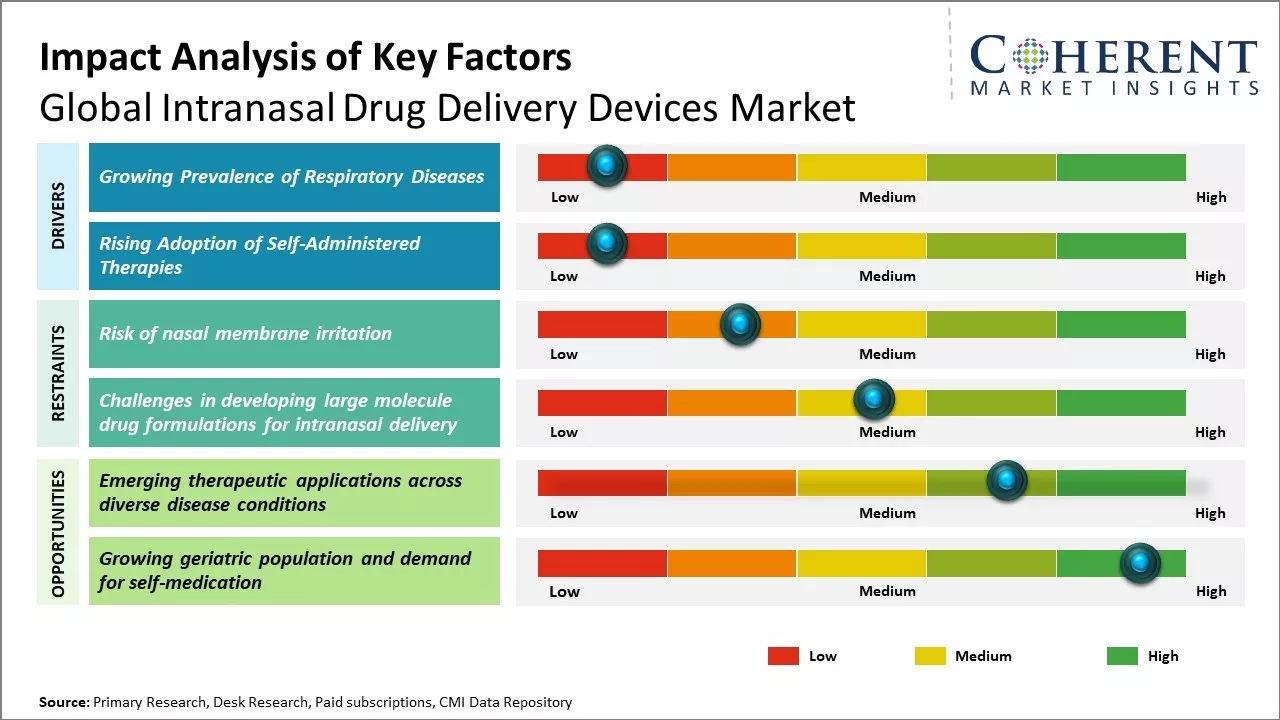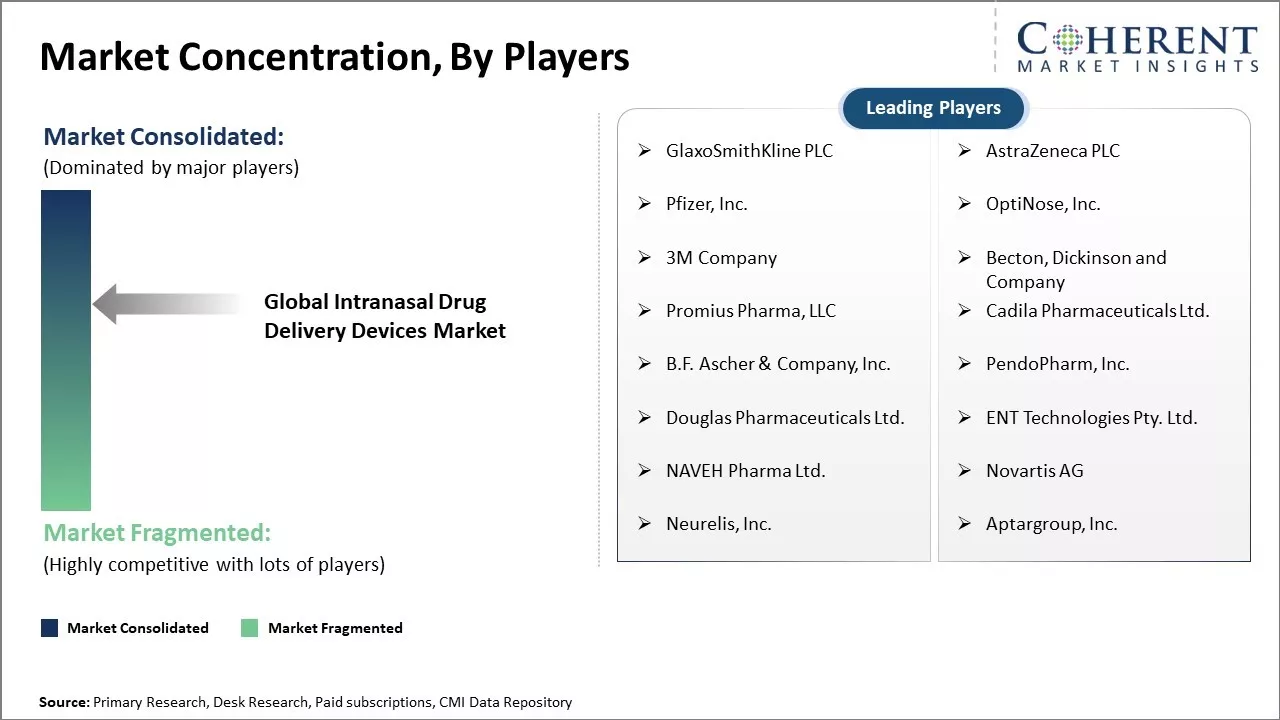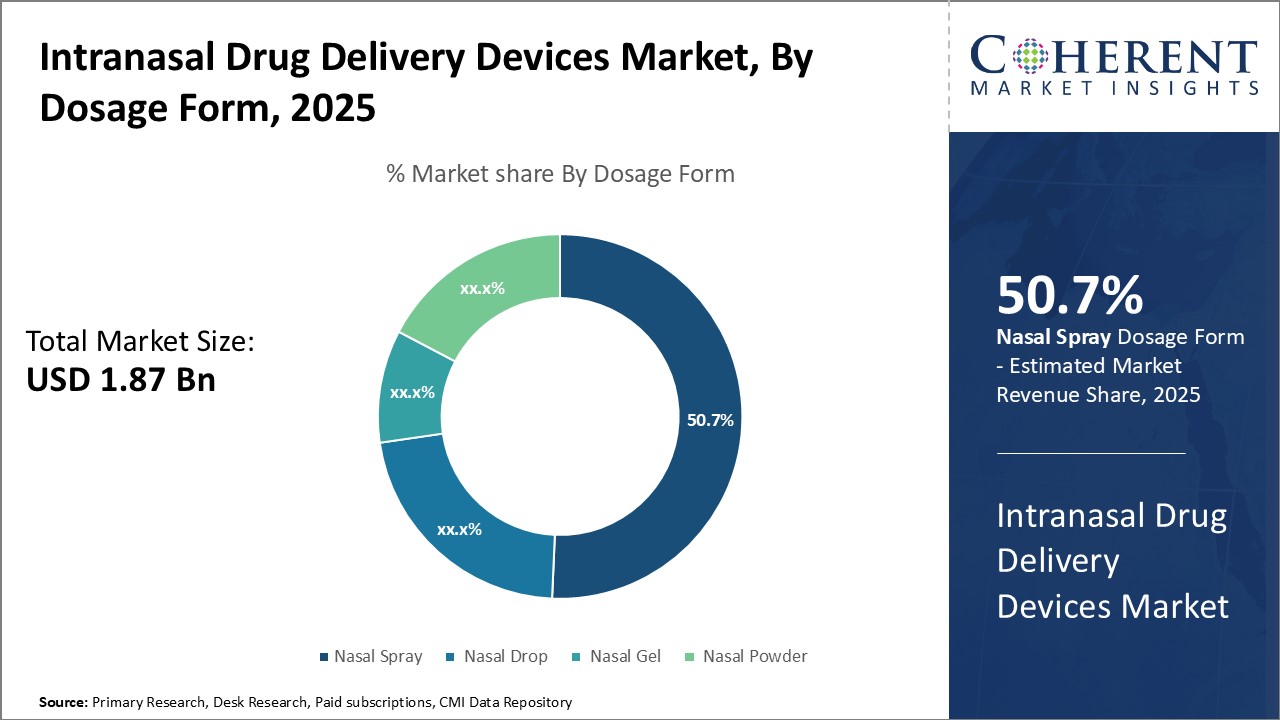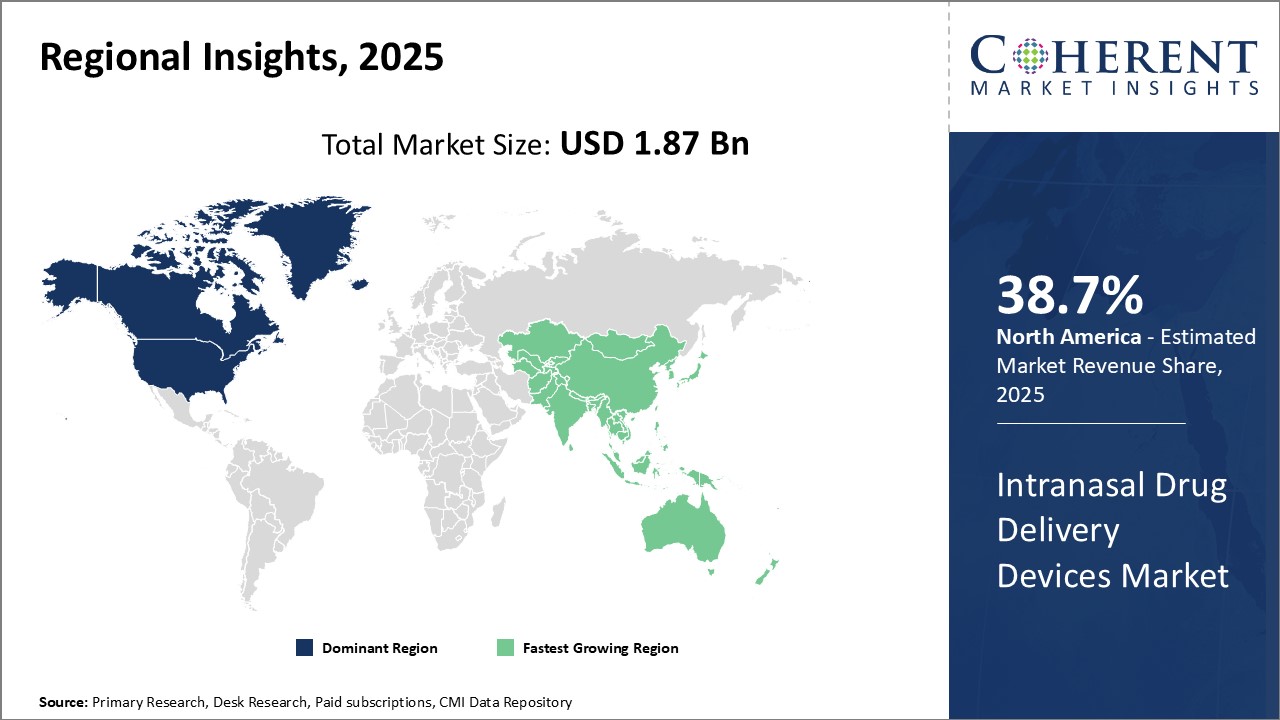Intranasal Drug Delivery Devices Market Size and Trends
Global intranasal drug delivery devices market is estimated to be valued at USD 1.87 Bn in 2025 and is expected to reach USD 3.65 Bn by 2032, exhibiting a compound annual growth rate (CAGR) of 10.0% from 2025 to 2032.

Discover market dynamics shaping the industry: Download Free Sample
Global intranasal drug delivery devices market growth is driven by rising prevalence of chronic diseases such as asthma and COPD, where intranasal drug delivery proves to be an effective mode of administration. Intranasal delivery allows for direct nose-to-brain drug delivery, which is beneficial for drugs targeting central nervous system conditions like migraine, Alzheimer's, depression, and others. This reduces the quantity of drugs required and provides quick relief and onset of action. Technological advancements leads to development of advanced and user-friendly intranasal spray delivery devices that increases consumer interest and adoption. Growing preference for needle-free drug delivery modes can also boost demand for these devices.
Growing Prevalence of Respiratory Diseases
Growing prevalence of respiratory diseases across the world can drive the global intranasal drug delivery devices market growth. According to the data from WHO, respiratory diseases such as asthma, chronic obstructive pulmonary disease (COPD) and upper respiratory tract infections are among the top ten causes of death globally. In 2020, al 3.83 million people died due to COPD, and COPD is projected to be the third leading cause of death worldwide by 2030. Increasing air pollution levels, aging population, and smoking rates contributes to rising cases of respiratory illnesses. Intranasal drug delivery provides direct access to the systemic circulation bypassing first-pass metabolism through an extensive blood vessel network in the nasal cavity. This speeds up drug absorption and provides faster therapeutic action, thus, making intranasal medications an attractive alternative for respiratory diseases. Compared to oral medications, intranasal inhalers and sprays also ensure better patient compliance and safety especially for chronic respiratory conditions which require frequent and long-term medication use. The non-invasive nature of intranasal delivery also improves access and accessibility to medications for vulnerable patient groups such as children, elderly and critically ill patients. For instance, in November 2023, since mid-October 2023, the World Health Organization (WHO) had been monitoring an uptick in respiratory illnesses among children in northern China. The Chinese National Health Commission reported a nationwide increase in respiratory diseases due to easing of COVID-19 restrictions and the onset of colder weather, leading to higher circulation of known pathogens like influenza, Mycoplasma pneumoniae, respiratory syncytial virus (RSV), and SARS-CoV-2. WHO requested additional data from China following reports of undiagnosed pneumonia clusters in children's hospitals in Beijing and Liaoning. Chinese health authorities confirmed increased cases of Mycoplasma pneumoniae since May and RSV, adenovirus, and influenza virus since October, attributing the rise to enhanced surveillance rather than novel pathogens or unusual clinical presentations.
Market Concentration and Competitive Landscape

Get actionable strategies to beat competition: Download Free Sample
Rising Adoption of Self-Administered Therapies
Rising emphasis on self-care and home-based treatment routines can drive the market growth due to factors like growing out-of-pocket medical costs, doctor shortages in some regions, and people's increasing health consciousness. For long-term conditions like asthma that require daily medication, self-administered therapies provide unmatched convenience over visiting clinics regularly. These improve treatment adherence and management of symptoms. Intranasal drug delivery enables the production of user-friendly formulations like sprays, gels, and drops that can be safely applied without any special skills. This makes nasal drug delivery well-suited for self-administered therapies.
Key Takeaways from Analyst:
Non-invasive nature and enhanced convenience of intranasal delivery makes it an attractive alternative to oral and injectable routes. Rising prevalence of respiratory diseases such as asthma and chronic obstructive pulmonary disease (COPD) has boosted demand for nasal sprays. Increased focus on developing devices for non-respiratory applications to expand treatment landscapes into neurological disorders and systemic conditions can drive the global intranasal drug delivery devices market growth.
Asia Pacific is expected to be the fastest growing regional market due to large patient pools, increased healthcare spending and growing acceptance of advanced drug delivery technologies. However, lack of reimbursement policies and high prices of novel devices can hamper the market growth in price sensitive developing regions. Furthermore, device innovation and the pipeline of intranasal drugs can drive the market growth. Companies investing in specialized devices optimized for specific disease applications may gain competitive advantage.
Collaboration between device makers and drug developers can maximize the benefits of intranasal delivery. Devices receiving approvals for non-respiratory therapies in developed markets can offer growth opportunities. Continued exploration of formulation technologies can expand the range of indications that can leverage this route of administration and its improved convenience.
Market Challenges: Risk of nasal membrane irritation
The risk of nasal membrane irritation can hamper the global intranasal drug delivery devices market growth. Intranasal delivery of drugs bypass the gastrointestinal tract and hepatic first-pass metabolism, allowing for direct entry of drug molecules into the systemic circulation. However, sensitive nasal mucosa is constantly exposed to active drug and excipient components. Repeated and prolonged exposure can cause irritation, inflammation and damage to the nasal mucosa over time. Patients who experience irritation of the nasal mucosa stop taking their recommended intranasal medication, resulting in non-compliance. Both the treatment and the pharmaceutical businesses that are investing in the creation of intranasal medication delivery systems have suffered greatly as a result of this. For instance, a 2020 study published in the European Archives of Oto-Rhino-Laryngology found that over one-third of patients experienced discomfort following four weeks of daily use of an intranasal steroid spray for allergic rhinitis. Twelve percent of the patients discontinued the medication because of uncomfortable nasal irritation symptoms.
Market Opportunities: Emerging therapeutic applications across diverse disease conditions
Emerging therapeutic applications across diverse disease conditions can offer opportunity for global intranasal drug delivery devices market growth. As researchers continue developing novel therapies for challenging diseases, the intranasal route is showing promise for better treatment outcomes. Intranasal delivery allows drugs to be rapidly absorbed into the bloodstream through the highly vascularized nasal mucosa, bypassing the first-pass hepatic metabolism and gastrointestinal degradation, enabling efficient systemic delivery. This makes intranasal delivery an attractive option for time-critical therapies. For example, intranasal spray formulations are being developed for emergency conditions like opioid overdose, insulin for diabetes, and naloxone for opioid overdose. Intranasal delivery is also well suited for central nervous system (CNS) targeting since the nasal cavity provides direct access to the brain via olfactory and trigeminal neurological pathways. Thus, many CNS drug development efforts are now exploring intranasal delivery routes for improved targeting for conditions like Alzheimer's, Parkinson's, migraine, and psychiatric disorders.

Discover high revenue pocket segments and roadmap to it: Download Free Sample
By Dosage Form - Convenience Boosts Demand for Nasal Spray
In terms of dosage form, nasal spray segment is estimated to contribute the highest market share of 50.7% in 2025, owing to its ease of administration. Nasal spray does not require any specialized training or skill to use, making it highly convenient for self-administration anywhere and anytime. The spray format ensures accurate dosing and quick delivery of drugs to the nasal cavity. This allows for swift therapeutic effects and easy adherence to dosage schedules. Nasal spray is also perceived as a discreet mode of drug intake as compared to other formats like nasal drops that are messier to use. The spray technology also protects drugs from gastric degradation, enhancing their bioavailability through direct nose-to-brain delivery. These advantages have increased patient preference for nasal sprays across a variety of therapeutic applications.
By Container Type - Pressurized Containers Lead
In terms of container type, pressurized containers segment is estimated to contribute the highest market share of 60.62% in 2025, owing to its superior dosing control. Pressurized containers ensure consistent dispersal of accurate drug doses through compressed gas propellants. This guarantees reproducible therapeutic outcomes. The contained pressure also allows for smaller package sizes without compromising dosing ability. This makes pressurized containers highly portable and convenient for on-the-go medication. Their reclosable lids help maintain product sterility for multi-dose administration. Such efficiencies have increased their adoption over non-pressurized variants across different drug classes.
By Application - Chronic Obstructive Pulmonary Disease Drives Maximum Utilization
In terms of application, chronic obstructive pulmonary disease (COPD) segment is estimated to contribute the highest market share of 25.5% in 2025, owing to the high incidence and severity of the condition. COPD severely restricts airflow and breathing, making nasal drug delivery highly effective. Nasal routes bypass the harm caused to lung tissue during inhaled administration in COPD patients. This makes compliance easier with fewer side effects. A variety of drugs employed in COPD management like corticosteroids and bronchodilators are now available as nasal formulations. Their non-invasive delivery provides swift relief from respiratory symptoms. These advantages have increased reliance on intranasal therapies for optimal COPD management.
Regional Insights

Need a Different Region or Segment? Download Free Sample
North America dominates the intranasal drug delivery devices globally with an estimated market share of 38.7% in 2025, due to the presence of major device manufacturers as well as favorable reimbursement policies for new drug delivery technologies in the region. The U.S. accounts for the maximum share due to the large healthcare expenditure and adoption of advanced medical devices. The medical devices industry is one of the most developed industries in the U.S., encouraging continuous innovations. Thus, there has been increasing demand for improved drug delivery methods like intranasal devices.
North America dominates due to the presence of major device manufacturers and supportive reimbursement policies. The Asia Pacific region is expected to witness highest growth due to improved healthcare infrastructure, low-cost manufacturing opportunities and rising chronic disease prevalence.
Asia Pacific region is poised to be the fastest growing market for intranasal drug delivery due to rising healthcare infrastructure and growing medical tourism industry across Asia Pacific countries. The large patient pool suffering from chronic conditions like diabetes and asthma that require intranasal drug delivery also drives the market growth. Countries like India and China offer low-cost manufacturing options, attracting many global device companies to establish production bases in the region. This increases the availability and affordability of intranasal devices in Asia Pacific.
Market Report Scope
Intranasal Drug Delivery Devices Market Report Coverage
| Report Coverage | Details | ||
|---|---|---|---|
| Base Year: | 2024 | Market Size in 2025: | USD 1.87 Bn |
| Historical Data for: | 2020 To 2024 | Forecast Period: | 2025 To 2032 |
| Forecast Period 2025 to 2032 CAGR: | 10.0% | 2032 Value Projection: | USD 3.65 Bn |
| Geographies covered: |
|
||
| Segments covered: |
|
||
| Companies covered: |
GlaxoSmithKline PLC, AstraZeneca PLC, Pfizer, Inc., OptiNose, Inc., 3M Company, Becton, Dickinson and Company, Promius Pharma, LLC, Cadila Pharmaceuticals Ltd., B.F. Ascher & Company, Inc., PendoPharm, Inc., Douglas Pharmaceuticals Ltd., ENT Technologies Pty. Ltd., NAVEH Pharma Ltd., Novartis AG, Neurelis, Inc., Aptargroup, Inc. |
||
| Growth Drivers: |
|
||
| Restraints & Challenges: |
|
||
Uncover macros and micros vetted on 75+ parameters: Get instant access to report
Intranasal Drug Delivery Devices Industry News
- In April 2024, Bespak completed its separation from Recipharm to establish itself as an independent organization dedicated to developing drug-device combination products and drug delivery devices specifically for pulmonary and nasal inhalation
- In November 2023, Hovione, a specialized integrated CDMO renowned for spray drying and particle engineering, launched an enhancement to its nasal drug delivery capabilities. This expansion includes a new line of advanced nasal powder delivery devices developed in collaboration with IDC. Intranasal drug delivery is increasingly favored over traditional methods for its ease, safety, and rapid onset of action, making it suitable for both local and systemic drug administration.
- In March 2023, Pfizer Inc. announced that the U.S. Food and Drug Administration (FDA) had approved ZAVZPRET (zavegepant), marking it as the first and only nasal spray calcitonin gene-related peptide (CGRP) receptor antagonist for treating acute migraine in adults, with or without aura
- In January 2023, Aptar Pharma, a division of AptarGroup, Inc. and a worldwide leader in drug delivery systems, services, and active material science solutions, introduced APF Futurity. Its inaugural metal-free, multidose nasal spray pump is designed for dispensing nasal saline and similar over-the-counter (OTC) formulations.
*Definition: Global Intranasal Drug Delivery Devices Market covers medical devices that deliver drugs to patients through the nasal passages. This includes devices such as unit dose spray pumps, metered dose inhalers, and nasal sprays used to administer various types of medications like decongestants, steroids, antihistamines, and others. The global market comprises manufacturers and suppliers of intranasal drug delivery devices catering to pharmaceutical companies developing nasal drug formulations for treatment of various acute and chronic diseases.
Market Segmentation
- Dosage Form Insights (Revenue, USD Bn, 2020 - 2032)
- Nasal Spray
- Nasal Drop
- Nasal Gel
- Nasal Powder
- Application Insights (Revenue, USD Bn, 2020 - 2032)
- Chronic Obstructive Pulmonary Disease (COPD)
- Rhinitis
- Cystic Fibrosis
- Nasal Congestion
- Asthma
- Others
- End User Insights (Revenue, USD Bn, 2020 - 2032)
- Ambulatory Surgical Centers
- Clinics
- Hospitals
- Others
- Regional Insights (Revenue, USD Bn, 2020 - 2032)
- North America
- U.S.
- Canada
- Latin America
- Brazil
- Argentina
- Mexico
- Rest of Latin America
- Europe
- Germany
- U.K.
- Spain
- France
- Italy
- Russia
- Rest of Europe
- Asia Pacific
- China
- India
- Japan
- Australia
- South Korea
- ASEAN
- Rest of Asia Pacific
- Middle East
- GCC Countries
- Israel
- Rest of Middle East
- Africa
- South Africa
- North Africa
- Central Africa
- North America
- Key Players Insights
- GlaxoSmithKline PLC
- AstraZeneca PLC
- Pfizer, Inc.
- OptiNose, Inc.
- 3M Company
- Becton, Dickinson and Company
- Promius Pharma, LLC
- Cadila Pharmaceuticals Ltd.
- B.F. Ascher & Company, Inc.
- PendoPharm, Inc.
- Douglas Pharmaceuticals Ltd.
- ENT Technologies Pty. Ltd.
- NAVEH Pharma Ltd.
- Novartis AG
- Neurelis, Inc.
- Aptargroup, Inc.
Share
Share
About Author
Komal Dighe is a Management Consultant with over 8 years of experience in market research and consulting. She excels in managing and delivering high-quality insights and solutions in Health-tech Consulting reports. Her expertise encompasses conducting both primary and secondary research, effectively addressing client requirements, and excelling in market estimation and forecast. Her comprehensive approach ensures that clients receive thorough and accurate analyses, enabling them to make informed decisions and capitalize on market opportunities.
Missing comfort of reading report in your local language? Find your preferred language :
Transform your Strategy with Exclusive Trending Reports :
Frequently Asked Questions
EXISTING CLIENTELE
Joining thousands of companies around the world committed to making the Excellent Business Solutions.
View All Our Clients
